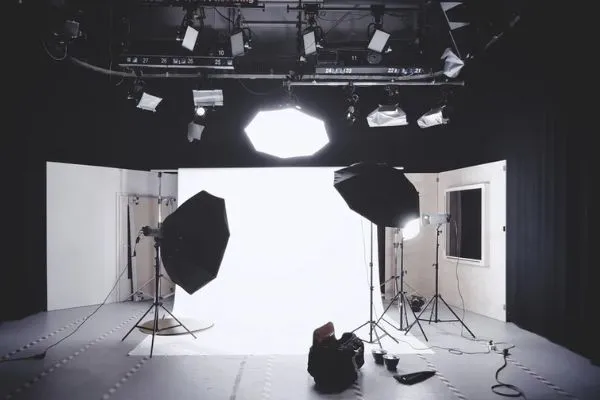When shooting self tapes at home, we worry more about the background than our performance. And your concern is not wrong.
If your background is not right, the focus will be diverted from you to the background.
So choose the right color for self-tapes.
Grey and blue are the best backdrop color for self-tapes. Grey is suited for drama film auditions, and blue background for comedy tv shows or commercials.
However, there are plenty more options, and you should know which color you should wear for your skin tone, genre, or costume type.
Best Backdrop Color For Self Tapes
Let’s look at all the backdrop colors suited for the self-tapes so that you can narrow it down to the right color for your audition.
Grey
The common practice in the industry is to use Grey for any kind of audition.
There is science behind grey being preferred as the backdrop color.
In our eyes, there are three sets of cones. Each cone senses a range of colors.
When we stare at a particular for an extended time, the cone responsible for sensing the color is fatigued, and the color we perceive will be skewed.
Another theory is that when you put a vibrant color in front of grey backdrop, there is a clear contrast.
This is why you will see that grey is generally preferred as a background.
However, you have to choose between dark grey and light gray.
Consider this rule while choosing one between the two.
Consider light grey as the alternative to white, so whatever subject you keep in front of it should be on the dark spectrum. Your skin tone or costume should be dark.
Similarly, consider dark grey as an alternative to black, and the subject color should be on the light spectrum. Actors with light skin tone or using light costumes should go for the dark grey background.
Blue
You should consider using a Blue backdrop when shooting auditions for commercials and TV shows.
If you see the color scale, the skin tone is far away from the blue color. So it is logical to use the blue background. You can create contrast between the background and the actor in self-tapes.
Many actors say that a blue backdrop makes their eyes more visible. This is good for actors because the eyes are an important part of the expression.
Also, actors with dark skin found that a blue screen works better than a grey backdrop with the same lighting.
The shot looked more alive and added a glow to their face.
However, choose darker blue color compared to light blue. It is more suitable for self tape.
Black
Many advise against using black backdrops because they think the entire shot will be too dark.
Especially if you wear dark clothing in front of a black backdrop and low lighting, it would be hard for casting people to see.
However, in my experience, the actor stands out against the dark backdrop when you put proper lighting.
You already know black absorbs light, so when you add proper lighting and wear light color clothing that reflects light, you can create amazing contrast.
The only thing to ensure is that you use black fabric as the background because vinyl or plastic paint tends to be a little reflective.
White
The use of white background is another best way to create contrast between the background and the subject.
However, white background requires some knowledge of lighting to get the best result.
I suggest using two lights with softboxes to light the actor and add even light for the backdrop. Make sure the background light doesn’t spill on the actor.
This way, you can create a great contrast between the actor and the backdrop.
Also, use dark color clothing for the scene so that all the focus in the frame is on you.
You don’t have to go for pure white. You can even choose different shades of white to make it more natural.
Green
I have heard many actors that avoid using the Green screen. It is too distracting for the casting agent.
Even sometimes, casting agents don’t like seeing auditions shot on green screen for too long because it’s too vibrant.
Well, they are not wrong.
This is also why the green screen is mostly used in CG work so that the editor can easily identify the green background and add graphics to it.
However, you can work with dark or even lighter green colors for the background.
Just follow the rule of using neutral colors as the backdrop. They should either absorb light or reflect maximum light. This is the best way to create a natural contrast.
What To Consider While Choosing The Color For Backdrop?
When choosing the backdrop, you should keep skin tone, genre, and costume in mind. This will allow you to create the perfect backdrop for each audition.
Skin Tone
When choosing the color for the backdrop, the most important question is which color suits my skin tone.
As I have said earlier, whatever background you use, you must stand out against the background. All the details of your face should be visible, including your eyes.
You have to use the same principle while choosing the backdrop keeping the skin tone in mind. Just follow this table:
| Skin Tone | Background |
| Dark | White shades and blue |
| Brown | White shades and blue |
| Wheatish | Grey and Black |
| Light | Grey, Blue, and Black |
Genre
Another aspect you must consider is the genre of the auditions.
Not too many actors consider this. But if you do, you will make the shot more dynamic and natural.
Advertisement people are too much particular about the colors. Each color tends to evoke certain emotions.
Big brands do the same thing. That is why you will see they make sure the color for their brand logo is right.
Coca-cola keeps the code of their red color a secret. Only very few in the company know about it.
If you want to take advantage of this principle for your audition, you should know which color to use for which genre.
| Genre | Backdrop |
| Drama | Grey |
| Action | Black, Blue |
| Comedy | Blue, White |
| Science Fiction | Blue, Green |
| Horror/Thriller | Grey, Black |
| Historical | Grey |
| TV commercials | Blue, White, Green |
Costume
Nothing throws off a casting agent than looking at an actor wearing the same costume as the backdrop.
The only thing you need to consider is to make sure the costume is in contrast to the backdrop.
If the backdrop is white, wear dark color clothing and keep it another way around for a black backdrop.
If you are using grey, wear a white or dark costume.
If you use blue, use any color in your costume but not blue itself. Same you have to keep in mind for green screen.
Also Read:
Final Thought
Now you have all the knowledge to choose the right color backdrop for self tape. If you want, you can try out different options to see which works best for you.


